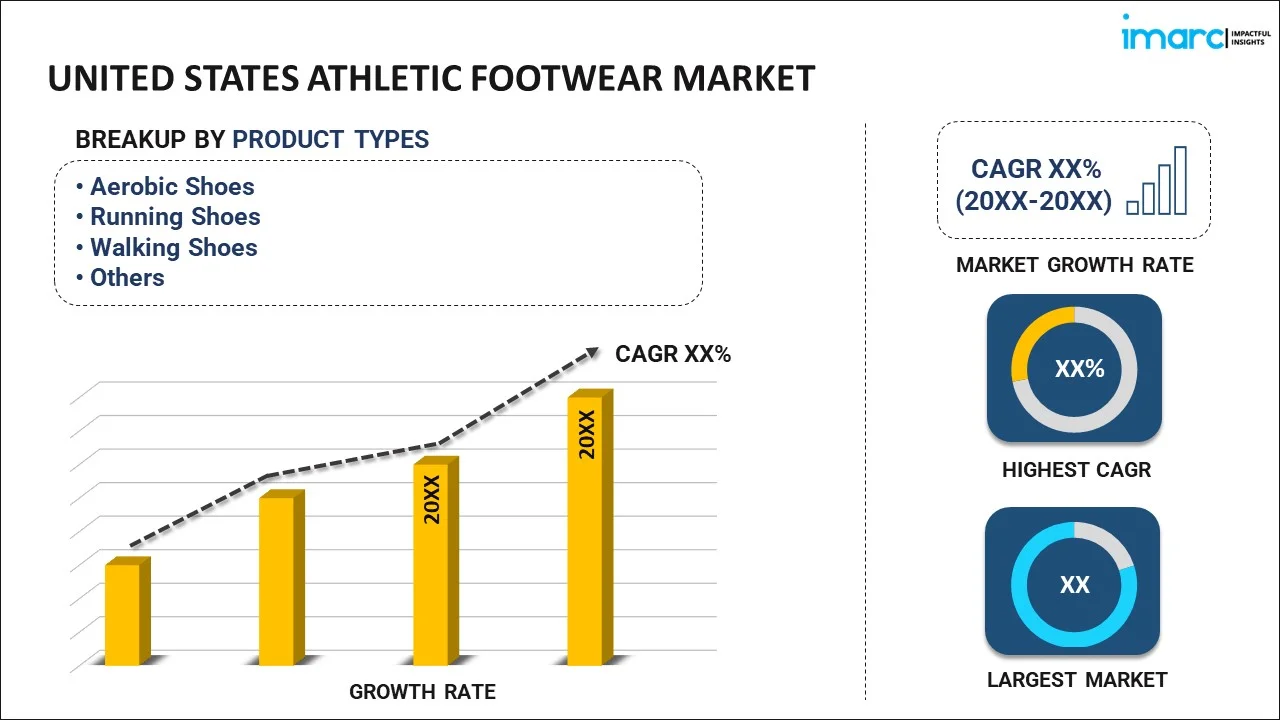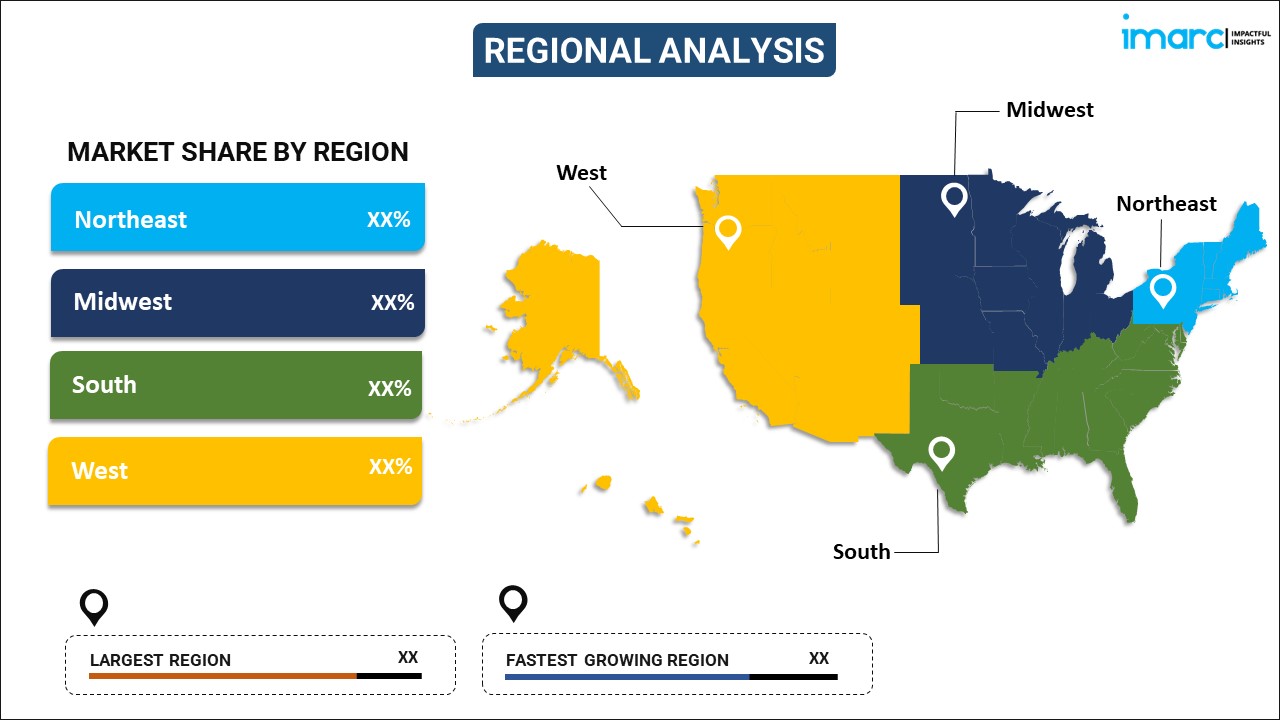
United States Athletic Footwear Market Report by Product Type (Aerobic Shoes, Running Shoes, Walking Shoes, Trekking and Hiking Shoes, Sports Shoes), Distribution Channel (Supermarkets and Hypermarkets, Specialty Stores, Brand Outlets, Online Channels), End User (Men, Women, Kids), and Region 2024-2032
Market Overview:
United States athletic footwear market size is projected to exhibit a growth rate (CAGR) of 3.10% during 2024-2032. The increasing demand for environmentally friendly materials and production processes that attract environmentally conscious consumers is driving the market.
|
Report Attribute
|
Key Statistics
|
|---|---|
|
Base Year
|
2023 |
|
Forecast Years
|
2024-2032
|
|
Historical Years
|
2018-2023
|
| Market Growth Rate (2024-2032) | 3.10% |
Athletic footwear has evolved from basic utility to a dynamic fusion of performance, style, and technology. Designed to support the unique demands of various sports and physical activities, modern athletic shoes are a testament to innovation and biomechanical research. These shoes are crafted with precision, integrating advanced materials and technologies to enhance comfort, stability, and performance. Whether it's running, basketball, tennis, or cross-training, athletic footwear is engineered to provide optimal support, cushioning, and traction. Specialized features such as breathable mesh uppers, responsive midsoles, and advanced outsole patterns contribute to the overall functionality of these shoes. Brands constantly push boundaries, introducing cutting-edge designs that not only cater to athletes' needs but also reflect current fashion trends. Beyond their functional attributes, athletic footwear has become a cultural phenomenon, influencing streetwear and everyday fashion. In essence, athletic footwear has transcended its utilitarian origins, becoming a symbol of performance, style, and cultural expression.
United States Athletic Footwear Market Trends:
The athletic footwear market in the United States is experiencing robust growth, driven by several key factors. Firstly, the increasing awareness of health and fitness has led to a surge in demand for athletic footwear as individuals prioritize an active lifestyle. Moreover, the rising prevalence of chronic diseases and the regional emphasis on preventive healthcare have propelled consumers towards adopting regular exercise routines, consequently boosting the demand for performance-oriented athletic footwear. Furthermore, the growing influence of fashion and trends in the athletic footwear segment has expanded the consumer base beyond traditional athletes. The convergence of style and functionality has made athletic footwear a popular choice for casual and everyday wear, driving market growth among a broader demographic. Additionally, technological advancements in materials and design have enhanced the performance attributes of athletic footwear, providing consumers with innovative solutions that cater to their evolving needs. Moreover, the surge in e-commerce platforms, which offer consumers a convenient and extensive array of options, is expected to drive the athletic footwear market in the United States during the forecast period.
United States Athletic Footwear Market Segmentation:
IMARC Group provides an analysis of the key trends in each segment of the market, along with forecasts at the country level for 2024-2032. Our report has categorized the market based on product type, distribution channel, and end user.
Product Type Insights:

- Aerobic Shoes
- Running Shoes
- Walking Shoes
- Trekking and Hiking Shoes
- Sports Shoes
The report has provided a detailed breakup and analysis of the market based on the product type. This includes aerobic shoes, rubbing shoes, walking shoes, trekking and hiking shoes, and sports shoes.
Distribution Channel Insights:
- Supermarkets and Hypermarkets
- Specialty Stores
- Brand Outlets
- Online Channels
A detailed breakup and analysis of the market based on the distribution channel have also been provided in the report. This includes supermarkets and hypermarkets, specialty stores, brand outlets, and online channels.
End User Insights:
- Men
- Women
- Kids
The report has provided a detailed breakup and analysis of the market based on the end user. This includes men, women, and kids.
Regional Insights:

- Northeast
- Midwest
- South
- West
The report has also provided a comprehensive analysis of all the major regional markets, which include Northeast, Midwest, South, and West.
Competitive Landscape:
The market research report has also provided a comprehensive analysis of the competitive landscape. Competitive analysis such as market structure, key player positioning, top winning strategies, competitive dashboard, and company evaluation quadrant has been covered in the report. Also, detailed profiles of all major companies have been provided. Some of the key players include:
- adidas America Inc. (Adidas AG)
- ASICS America Corporation
- Avia
- New Balance Athletics, Inc.
- Nfinity Athletic Corporation
- Nike Inc.
- Puma North America Inc. (Puma SE)
- Skechers USA Inc.
- Under Armour Inc.
(Please note that this is only a partial list of the key players, and the complete list is provided in the report.)
United States Athletic Footwear Market Report Coverage:
| Report Features | Details |
|---|---|
| Base Year of the Analysis | 2023 |
| Historical Period | 2018-2023 |
| Forecast Period | 2024-2032 |
| Units | US$ Million |
| Scope of the Report | Exploration of Historical and Forecast Trends, Industry Catalysts and Challenges, Segment-Wise Historical and Predictive Market Assessment:
|
| Product Types Covered | Aerobic Shoes, Running Shoes, Walking Shoes, Trekking and Hiking Shoes, Sports Shoes |
| Distribution Channels Covered | Supermarkets and Hypermarkets, Specialty Stores, Brand Outlets, Online Channels |
| End Users Covered | Men, Women, Kids |
| Regions Covered | Northeast, Midwest, South, West |
| Companies Covered | adidas America Inc. (Adidas AG), ASICS America Corporation, Avia, New Balance Athletics Inc., Nfinity Athletic Corporation, Nike Inc., Puma North America Inc. (Puma SE), Skechers USA Inc., Under Armour Inc., etc. (Please note that this is only a partial list of the key players, and the complete list is provided in the report.) |
| Customization Scope | 10% Free Customization |
| Report Price and Purchase Option | Single User License: US$ 3699 Five User License: US$ 4699 Corporate License: US$ 5699 |
| Post-Sale Analyst Support | 10-12 Weeks |
| Delivery Format | PDF and Excel through Email (We can also provide the editable version of the report in PPT/Word format on special request) |
Key Questions Answered in This Report:
- How has the United States athletic footwear market performed so far and how will it perform in the coming years?
- What has been the impact of COVID-19 on the United States athletic footwear market?
- What is the breakup of the United States athletic footwear market on the basis of product type?
- What is the breakup of the United States athletic footwear market on the basis of distribution channel?
- What is the breakup of the United States athletic footwear market on the basis of end user?
- What are the various stages in the value chain of the United States athletic footwear market?
- What are the key driving factors and challenges in the United States athletic footwear?
- What is the structure of the United States athletic footwear market and who are the key players?
- What is the degree of competition in the United States athletic footwear market?
Key Benefits for Stakeholders:
- IMARC’s industry report offers a comprehensive quantitative analysis of various market segments, historical and current market trends, market forecasts, and dynamics of the United States athletic footwear market from 2018-2032.
- The research report provides the latest information on the market drivers, challenges, and opportunities in the United States athletic footwear market.
- Porter's five forces analysis assist stakeholders in assessing the impact of new entrants, competitive rivalry, supplier power, buyer power, and the threat of substitution. It helps stakeholders to analyze the level of competition within the United States athletic footwear industry and its attractiveness.
- Competitive landscape allows stakeholders to understand their competitive environment and provides an insight into the current positions of key players in the market.
Need more help?
- Speak to our experienced analysts for insights on the current market scenarios.
- Include additional segments and countries to customize the report as per your requirement.
- Gain an unparalleled competitive advantage in your domain by understanding how to utilize the report and positively impacting your operations and revenue.
- For further assistance, please connect with our analysts.
 Inquire Before Buying
Inquire Before Buying
 Speak to an Analyst
Speak to an Analyst
 Request Brochure
Request Brochure
 Request Customization
Request Customization




.webp)




.webp)












